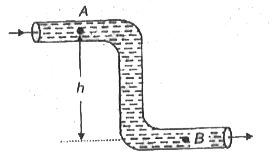The cross-section area of the pipe shown in Fig. is 50cm2 at the wider portions and 20cm2 at the constriction. The rate of flow of water through the pipe is4000cm3/s. Find ,
(i) the velocities at the wide and the narrow portions
(ii) the pressure difference between these portions
(iii) the difference in height between the mercury columns in the U-tube.
The correct Answer is:(i)0.8ms−1,2ms−1(ii)1680Pa(iii)0.−013m
To solve the given problem step by step, we will address each part of the question sequentially.
Given Data:
- Cross-sectional area at wider portion, A2=50cm2=50×10−4m2
- Cross-sectional area at constriction, A1=20cm2=20×10−4m2
- Rate of flow of water, Q=4000cm3/s=4000×10−6m3/s
(i) Finding the velocities at the wide and narrow portions
Using the equation of continuity:
Q=A1v1=A2v2
1. Calculate velocity at the narrow portion v1:
v1=QA1=4000×10−620×10−4=400020=200cm/s
2. Calculate velocity at the wide portion v2:
v2=QA2=4000×10−650×10−4=400050=80cm/s
(ii) Finding the pressure difference between these portions
Using Bernoulli's equation:
P1+12ρv21=P2+12ρv22
Rearranging gives:
P1−P2=12ρ(v22−v21)
Where ρ (density of water) is approximately 1000kg/m3.
1. Calculate the pressure difference:
P1−P2=12×1000×(802−2002)
=12×1000×(6400−40000)
=12×1000×(−33600)=−16800000Pa
Thus, the pressure difference P1−P2=1680N/m2 (positive value indicates pressure at wider section is higher).
(iii) Finding the difference in height between the mercury columns in the U-tube
Using the relationship between pressure difference and height of mercury column:
P=ρHggh
1. Rearranging gives:
h=P1−P2ρHgg
Where ρHg≈13600kg/m3 and g≈9.8m/s2.
2. Calculate the height difference:
h=168013600×9.8
=1680133280≈0.0126m=12.6mm
Summary of Results:
- (i) v1=200cm/s, v2=80cm/s
- (ii) Pressure difference =1680N/m2
- (iii) Height difference =12.6mm
- Cross-sectional area at wider portion, A2=50cm2=50×10−4m2
- Cross-sectional area at constriction, A1=20cm2=20×10−4m2
- Rate of flow of water, Q=4000cm3/s=4000×10−6m3/s
Q=A1v1=A2v2
v1=QA1=4000×10−620×10−4=400020=200cm/s
v2=QA2=4000×10−650×10−4=400050=80cm/s
P1+12ρv21=P2+12ρv22
Rearranging gives:
P1−P2=12ρ(v22−v21)
Where ρ (density of water) is approximately 1000kg/m3.
P1−P2=12×1000×(802−2002)
=12×1000×(6400−40000)
=12×1000×(−33600)=−16800000Pa
Thus, the pressure difference P1−P2=1680N/m2 (positive value indicates pressure at wider section is higher).
P=ρHggh
h=P1−P2ρHgg
Where ρHg≈13600kg/m3 and g≈9.8m/s2.
h=168013600×9.8
=1680133280≈0.0126m=12.6mm
- (i) v1=200cm/s, v2=80cm/s
- (ii) Pressure difference =1680N/m2
- (iii) Height difference =12.6mm
Topper's Solved these Questions
- MOTION IN FLUIDS Book:ICSEChapter:MOTION IN FLUIDS Exercise:SELECTED PROBLEMS ( FROM VISCOSITY , STOKES LAW)
Explore 17 Videos
- INTERNAL ENERGY Book:ICSEChapter:INTERNAL ENERGY Exercise:SELECTED PROBLEMS (FROM HEAT ENGINES)
Explore 21 Videos
- OSCILLATIONS Book:ICSEChapter:OSCILLATIONS Exercise:SELECTED PROBLEMS (OSCILLATION IN A TUNNEL BORED THROUGH THE EARTH)
Explore 2 Videos
Similar Questions
Water flows through the tube shown in figure. The areas of cross section of the wide and the narrow portions of the tube are 5cm2and2cm2 respectively. The rate of flow of water through the tube is 500cm3s−1 . Find the difference of mercury levels in the U-tube.

View SolutionWater flows through the tube shown in figure. The areas of cross section of the wide and the narrow portions of the tube are 5cm2and2cm2 respectively. The rate of flow of water through the tube is 500cm3s−1 . Find the difference of mercury levels in the U-tube.

View SolutionThe area of cross-section of the wider tube shown in fig., is 800cm2 . If a mass of 12 kg is placed on the massless piston, what is the difference in the level of water in two tubes.

View SolutionThe area of cross section of the wider tube shown in figure is 900cm2. If the boy standing on the piston weights 45 kg, find the difference in the levels of water in the two tubes.

View SolutionWater contained in a tank flows through an orifice of a diameter 2 cm under a constant pressure difference of 10 cm of water column. The rate of flow of water through the orifice is
View SolutionA broad pipe having a radius 10cm branches into two pipes of radii 5cm and 3cm. If the velocity of flowing water in the pipe of radius 3cm is 5cm/s, determine the velocities of water in the remaining two pipes. Given that the rate of discharge through the main branch is 600πcm3/s.
View SolutionIt the difference between the sides of right angles triangle is 3 cm and its area is 54 cm2. Find its perimeter.
View SolutionIf the difference between the sides of a right angled triangle is 3 cm and its area is 54 cm2, find its perimeter.
View SolutionIn this figure, an ideal liquid flows through the tube having uniform area of cross-section and is held in vertical plane. Find the ratio of speed of liquid at A and B and also find the pressure difference between- these points.

View SolutionA gardener holds a pipe of inside cross-sectional area 3.60cm2 at a height of 1.50m from ground. The opening at the nozzle of pipe has cross-sectional area 0.250cm2. Water velocity in the segment of the hose that lies on the ground is 50.0cm/s. a. What is the velocity of water leaving the nozzle? b. What is the thrust force experienced by the gardener due to flow of water through nozzle. c. What is the water pressure in the hose on the ground?
View Solution